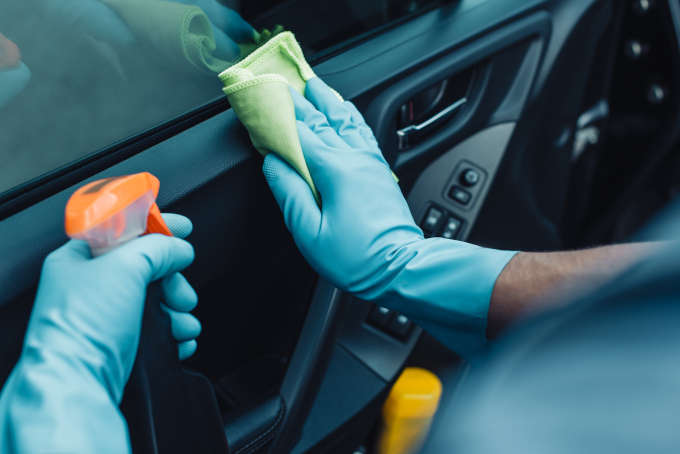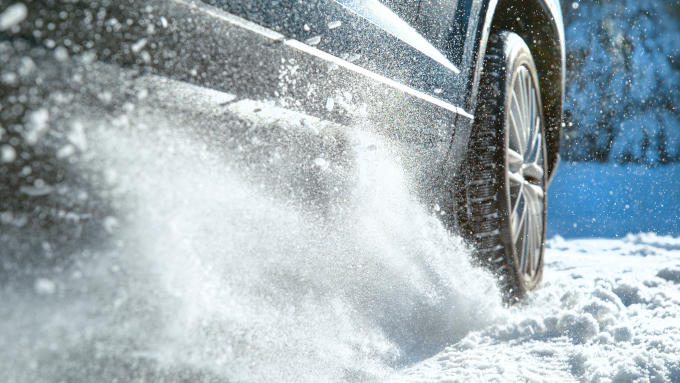Whether you're an essential or non-essential worker, chances are your vehicle may not be one of the places you routinely clean. However, your vehicle can harbor germs that can get you sick, especially on surfaces that are high-touch. Therefore, cleaning and disinfecting your vehicle — especially during a pandemic — can be a significant step to help ensure the safety of you and your passengers.
Here are the items needed to clean and disinfect your vehicle:
- Vacuum cleaner
- Bucket of soapy, warm water
- Microfiber cloths (excellent for water absorption and picking up dirt)
- Clean rags
- Soft-bristled brush (to prevent the scratching of soft surfaces)
- Cotton balls or soft-bristled toothbrush (for hard to reach and delicate surfaces)
- Disposable gloves
- Goggles and face mask
You should wear clothes that can be immediately laundered afterward, and, if possible, a mask and goggles to protect your face from exposure to any cleaning solutions as well as from touching your face while you clean. You can easily make a face mask if none are readily available.
Which Cleaning Agents to Use
To start, refrain from using bleach, hydrogen peroxide, and ammonia products on the interior of your vehicle. While these cleaning agents are suitable for cleaning and disinfecting your house, they can discolor and damage the interior of your vehicle. Don't mix chemicals and never mix ammonia and bleach — it can have deadly effects in large doses.
Gentler solutions, such as soap and water, can also kill the coronavirus just as effectively as harsh disinfecting agents. Additionally, cleaning hard surfaces with 70% isopropyl alcohol has been tested in the automotive industry and is considered safe on most car interiors, including leather. As with any cleaning solution you haven't used before, make sure to test it on a small area first to make sure it won't affect the vehicle’s interior color.
Cleaning and Disinfecting
Start by removing all debris from the car: toys, clothes, and garbage that can be recycled or thrown out. Some helpful advice for cleaning and disinfecting toys can be found here. Clothes may be laundered as usual.
Next, vacuum the car. Start high and go low, beginning with the ceiling and ending at the floor. Remember to remove the mats to get the dirt underneath them. Vacuuming will remove any particles and debris that may scratch or damage soft surfaces while cleaning. Lastly, use a damp cloth or rag for a quick wipe-down of surfaces to help remove any additional dirt and grime.
Areas to Focus On
When cleaning, you'll want to focus most on high-touch surfaces such as the steering wheel, glove compartment, console, door handles, windows, vents, rims of your review mirror, and cup holders. Also, don't forget the backs of seats or floor mats. These areas are most often overlooked. You want to make sure you decontaminate any potential area where germs may be.
As for upholstery, below are a few general cleaning tips and a few more detailed suggestions for each type of interior.
Upholstery Cleaning Tips
- Avoid harsh detergents or solvents since they are not recommended for any vehicle's interior, including carpets.
- Always go light when applying cleaning solutions and then repeat the process if necessary. This method is more effective at removing grunge and stains than one heavy application.
- Excessive use of water can seep into cushions and encourage mildew. For leather, too much water can also cause staining.
- Alcohol-based wipes, if available, are acceptable for disinfecting and treating stains on hard and soft surfaces of your vehicle, including leather.
Fabric or Cloth Upholstery
This material has increased susceptibility to staining from spills, greasy food, and body oils.
To clean, gently spray cleaner directly onto the upholstery. Allow the cleaning product to soak into the fabric before blotting it with a clean, damp cloth. For stubborn stains, lightly scrub them with a soft-bristled brush and repeat as many times as necessary. If possible, leave the windows open to allow for quicker drying.
Using a high-quality fabric protectant can make future cleanings much easier and more effective because it creates a barrier against the damage of food spills and other mishaps, especially if children are routine riders.
Vinyl Upholstery
Vinyl upholstery is a sturdy material, requires little maintenance, and can be easily cleansed with most all-purpose upholstery cleaners.
To clean, add a small amount of cleaner to a clean, damp cloth and wipe down the upholstery. For additional stain removal, use a soft-bristled brush. Reapply if necessary.
Leather Upholstery
There are two types of leather upholstery in cars: coated and uncoated. Coated leather has a clear, synthetic covering added. This type of leather treatment is used in nearly all modern cars today, no matter the price, make, or model. When it comes to care, coated leather is identical to that of vinyl. Uncoated leather does not have a synthetic coating and is common among older vehicles, though a few modern luxury vehicles also use uncoated leather. To find out which type of leather interior your vehicle has, apply a drop of water on the leather and leave it there for 20-30 seconds. If a spot remains once you remove the droplet, the upholstery is uncoated leather. In this case, it is essential to get the right cleaner that is leather safe.
To clean, add a small amount of leather solution to a clean, damp rag. In a circular, overlapping motion, gently rub the cleaner into the leather. Wipe excess cleaner off with a clean, dry cloth.
How to Keep Your Car Clean as COVID-19 Continues
It's up to all of us to slow the disruptive and deadly spread of this virus. Here are some additional tips for keeping your car clean.
Wash your hands
Consistently washing your hands for at least 20 seconds before and after any activity can help prevent cross-contamination between your home, your car, the store, and work (if you're an essential employee). This simple act is proven to reduce germs. Follow the CDC's handwashing guidelines here.
Travel less, stay home
If you're not a frontline worker or an essential employee, stay home and only use your car when necessary. The less you use your vehicle, the less frequently germs can contaminate it.
Social distance
Essential reasons to use your vehicle include grocery shopping, medical purposes, helping high-risk community members, or fulfilling an indispensable role. Other than that, you should avoid going out as much as possible.
Final thoughts
Cleaning and disinfecting your car is an extra preventative measure you can take to help protect yourself and those around you from COVID-19. For more about the coronavirus, be sure to visit the CDC and WHO for reliable information.










